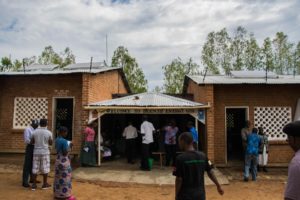In Phalombe, Dzenje Primary School was named after yawning pits in a neighbouring river that runs dry in the abundance of sunshine. Just a decade ago, the school was mostly shunned, with no pupils selected to secondary school and teachers preferring urban alternatives.
Now, there are 35 teachers at the school that received the MBC Innovative Award from President Peter Mutharika and they have sent 72 pupils to various secondary schools. Its head teacher Felix Ngalande, who received the surprise prize at Kamuzu Palace in Lilongwe, is excited with the feat.
“We were utterly happy to receive the award from the president, but the story got better this year,” he says. “Out of 154 who sat Primary School charge mobile phones they use Leaving Certificate of Education for browsing new information on [PLSCE] examinations this year, the worldwide web.” only two girls have failed, 13 wentto coveted national secondary school s, 20 to Phalombe Secondary School and 39 to Ngozi Community Day Secondary School in the neighbourhood.”
Just 15 students went to secondary school when Ngalande arrived from Ufa Primary School four years ago. The school’s secret to success? The teacher, 47, gazes to the sky, saying: “God’s grace, team play and solar lights.” He explains: “On arrival, I quickly realised that I wasn’t going to achieve anything without a united teaching staff. So, behind the successful learners are teachers and pupils working really hard to achieve the very best.
“Interestingly, the two solar bulbs installed in Standard Eight class help the learners do their homework and study longer everyday. The teachers also use the lights to conduct make-up classes, plan for next day’s lessons and
charge mobile phones they use for browsing new information on the worldwide web.”
Ngalande shined the light to coveted national secondary on the rising pass rates that school s, 20 to Phalombe
once scared learners away from Secondary School and 39 to Ngozi the school with 3 320 pupils Community Day Secondary scrambling for 14 classrooms, School in the neighbourhood.” four latrines and one borehole. Four classes learn in tree shades.
It enrols children from as far as Zomba, Mulanje and Chiradzulu districts who rent huts in surrounding villages and study hard using solar lights to ramp up their performance.
The power of the sun converted to electricity by two glistening panels perching on the rooftop of the Standard Eight block is also pulling teachers to the school not connected to the rural electrification grid that stops at Dzenje Trading Centre.

“We remain unconnected due to lack of money for wiring, but solar energy helps pupils from near and far to study when they should have been fast asleep if they were at home.
“Since we won the award, head advisers from Machinga, Thyolo and Mangochi have been visiting us to learn our secret to success. This would not have been possible during our dark days.”
Previously, pupils were studying under torchlight, barring those could not afford dry cells. The Standard Eight pupil , who have returned to school a week into the end-of-year vacation, say solar lighting is better than torchlight because there is no need to replace batteries frequently.
In this way, they can do school work after sunset and learn from what they are watching on television. Seven years ago, Renewable’N’Able Malawi ( Renama ) installed the energy kiosk at Dzenje and Bvumbwe Chief ’s Court to stimulate productive use of green and inclusive energy.
Devine Matale, from Renama, is excited that the off-grid populations can charge their phones, run grinding mills, operate barbershop and rent solar systems at a fee. He explains: “Th e most pleasing outcome is that since we put lights at Dzenje Primary School, teachers started running evening and boarding classes three months prior to exams. “As a result, the school is school number one in Phalombe in terms of the number of learners selected to secondary schools, which has more than tripled since the start of the project.”
Interestingly, the bulbs were initially not part the project. Nowadays, the rural school electrification component is part of the energy kiosks installed at Bvumbwe, Gombwa, Mtundama, Kwanjana and Mphedzu between June and July. The green and inclusive energy project aims at to accelerating access to solar energy technology.
The 2018 census shows six percent of households in the country use solar energy for lighting. This is almost double the reach of hydropower provided by Electricity Supply Corporation of Malawi (Escom), which has risen by one percent in the past decade.
According to Department of Energy Affairs spokesperson Saidi Banda, harnessing the power of sunlight is part of the revised National Energy Policy adopted last year. It calls for diversification from just relying on hydropower from the drying Shire River to achieve access to electricity for all by 2030 in line with Sustainable Development Goals.
He explains: “The marginal rise in access to electricity from 10 percent to 11.4 percent shows we still can do more and government has already doing more to change the status. “Our target is to have universal access by 2030, of which 30 percent will be access to the grid while the remaining 70 percent through other strategies like solar home systems, mini-grids and pico products.”
Meanwhile, Ngalande wishes the school connected to the grid powering the trading centre, with surrounding areas excluded.He says: “With electricity for all, we will be sending more pupils to secondary school and saving trees being burnt for cooking.”

